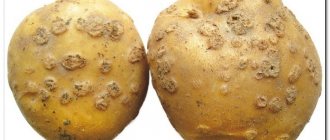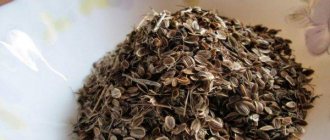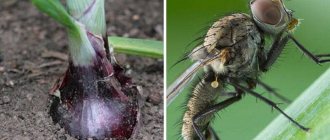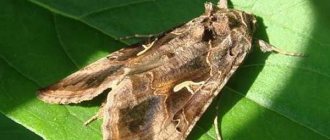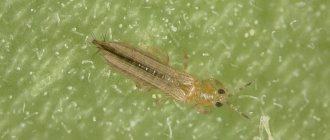Related Posts
- Why bedbugs appeared in the apartment: causes and signs, probable sources
- Black spot of roses. Prevention and treatment
- What do house bugs look like?
Wireworm is considered one of the main potato pests. These are click beetle larvae that damage tubers by making tunnels in them. Damaged potatoes cannot be stored for long periods of time and are difficult to clean. To destroy the pest on the site, you should use wireworm preparations for potatoes or folk remedies.
Harm from wireworm
Much damage is caused precisely by the larvae of beetles called wireworms.
The following beetles are considered dangerous for agriculture:
- Agriotes – sowing, species: dark (dark yellow with shine).
- Athous – appearance: black (black, with a brown tint).
- Selatosomus – species: shiny (light yellow with shine).
- Melanotus – species: pointed (the color of the body on the back is orange in all shades, including brown).
- Limonius – species: yellowlegged (yellowish-brown, caramel shade).
Their larvae damage potato tubers and stems (up to 60% of the harvest), buds and shoots of grapes, and affect other garden and horticultural crops. The plant stops developing, the fruits lose quality.
The larvae gnaw through passages into which pathogenic bacteria (rot, mold, etc.) penetrate. They harm:
- Zernov.
- Vegetable.
- Cabbage.
- Paslenov.
- Root crops.
The gluttony of pests increases with the onset of hot, dry weather: they look for root crops containing moisture, and accordingly cause more damage to the plant. In dry months, it is worth moistening the soil more.
There are benefits from this pest: they destroy the root system of weeds, promote soil ventilation, are beneficial insects in the food chain, and alert people to the presence of acidity in the soil.
Dolomite flour saves your finances
Soil acidity can also be reduced using wood ash. But you have to sprinkle it quite generously. To achieve the desired effect on equal areas, you need to use 2 times more ash and lime than dolomite flour. And if you consider that the latter costs less than the previous two, then its use saves you a lot of money.
Do you use dolomite flour on your site or do you prefer other methods of reducing soil acidity?
We suggest you read: Itchy scalp: 4 reasons and a review of 2 remedies
Fighting methods
- Mechanical methods: digging the soil.
- Setting bait traps.
- Reducing the acidity of the earth.
- Application of biochemical substances.
- Sevosmena.
- Eradication of weeds, burning of plant residues.
Creeping wheatgrass attracts them the most. If there is no sowing change (crops are planted constantly in one place), the reproduction of beetles occurs more intensively.
Mechanical methods
The pest will not disappear from the site on its own. A “one-sided” fight against him will not help either. In addition to the use of traditional methods and pesticides, special attention is paid to the mechanical method of control.
Autumn-spring work to destroy wireworms:
- In the fall before frost: dig the entire planting area very deeply, turning over the layer of soil. Most larvae will not survive frost.
- In the spring before planting: dig up the soil shallowly, picking out beetles and their larvae by hand.
- During the growing season of plants:
- In summer, maintain sufficient soil moisture (especially where the trap is located) so that the larvae are less likely to spoil root crops.
- Eradication of weeds (heaps are taken outside the site and burned).
The thing is that several generations of wireworms live in one place, each year turning into adults, laying eggs again.
The owner should scrupulously follow all recommendations for the destruction of larvae in order to quickly get rid of the pest.
Using Traps
You can catch wireworms all season – from April to October.
For bait, people have come up with several types of traps:
- Using whole potatoes: 7-10 days before planting, soak the potatoes (without eyes, sprouts) for 24 hours in any insecticidal preparation, then bury them between the rows of plantings. After 3 days, dig it up, destroy the wireworms, bury it again (repeat several times).
- Some time before planting, bury pickled grain in the beds: soak corn and oats in insecticide and bury them in heaps. Mark the places. Periodically replace the grain with new grain and burn the old grain.
- Using cut vegetables: string large pieces of raw root vegetables (carrots, beets) or potatoes onto a wooden stick, bury them in the spaces between the rows (approximate depth - 7-10 cm). Periodically dig up, destroy pests, bury again (the entire growing season).
- The bait for click beetles is laid out in half-liter jars (1 piece per 10 sq. m): cut potatoes (carrots, beets) are placed at the bottom of the container, buried between planted crops flush with the ground. Banks are checked every day.
- Lettuce is planted between the rows (a bait for larvae), and after a while it is dug up: the roots along with the wireworm are destroyed.
- They leave piles of wet straw in several places, and after 6-8 days , carefully collect them and destroy them outside the site. New piles are placed in the same place.
The place where the trap is buried must be marked (with a twig or some other visible material). Instead of bait, wireworms can be scared away from the beds by planting legumes everywhere (along the perimeter, between the rows). Beetles and their larvae especially do not like peas and beans.
The use of various substances for application to the soil
Many people do not consider the use of insecticides and pesticides to be such a necessary way to combat wireworms. According to the observations of folk craftsmen, the use of homemade products destroys the pest no worse than industrial ones.
Folk substances:
- Potassium permanganate: before planting, make an aqueous solution (2 g/10 l), pour the area of the future bed so that the soil gets wet 15-25 cm deep. You can treat it with it while planting potatoes: pour 5 liters of solution into one hole.
- Wood ash (neutralizes soil acidity): sprinkled between the rows in a layer of 1-5 cm.
- Mineral salt (ammonium): destruction of larvae + feeding of root crops.
According to experts, the simultaneous use of industrial means and folk methods only increases the chance of quickly destroying wireworms. You just need to follow the dosages and instructions for their use.
Industrial products against wireworms
After using chemicals against pests, people are not recommended to visit the treated area for 1-10 days (see instructions).
Industrial preparations that are allowed to be used on personal plots:
- Apply once, upon planting:
- "Barguzin".
- "Initiative".
- "Provotox."
- "Medvetox".
- "Technoexport".
- "Zemlin."
- Tubers are processed (1 time):
- "Taboo, VSK."
- "Prestige, KS."
- Bayer CropScience.
The above products are classified as hazard class 3 to human health. These drugs are safe for bees (other beneficial insects).
Dolomite flour heals the soil
Dolomite flour suppresses soil infections: cabbage clubroot, scab.
It activates the activity of beneficial microorganisms and annelids, which help improve the health of the soil. According to the Mitlider method, 7-8 g of boric acid is added to this fertilizer (per 1 kg of dolomite). The mixture is scattered on the surface of the soil, then buried to a depth of 10-15 cm. On heavy soils, use 200 g of this fertilizer per linear meter of a bed 40-45 cm wide, and on light soils - 100 g.
In heavy clay soil, dolomite flour is added annually, and on lighter soils it is sufficient to use it once every 2-4 years.
Prevention instead of wireworm control
Click beetles often settle in areas with a large amount of wheatgrass: it is considered their most favorite shelter and food. Therefore, the weed must be eradicated first.
How to distinguish click beetles from other species:
- Place the beetle on its back.
- When he begins to roll over onto his belly, a click is heard.
Ground toads and ground beetles (predatory beetles, polyphagous) love to feast on wireworms. Some farms are experimenting, specifically breeding them for the purpose of pest prevention.
Rules of preventive methods:
- Neutralize the acidity of the soil with liming (egg shells, chalk): wireworms develop well in acidic soil.
- Maintain certain distances between plants: the larvae gather in dense plantings.
- Disinfect the soil by humus with a hot solution of potassium permanganate.
- Use mineral fertilizers containing ammonium (ammonium sulfate).
- After autumn harvesting, collect all remnants of vegetation (weeds, crop roots) from the area of the beds and take them outside the site or destroy them.
Where one click beetle is found, there are sure to be their larvae (wireworms), laid eggs, and other adults.
Start fighting them immediately: the beetles multiply quickly and without taking measures to destroy them, within 2-3 seasons they will fill the entire potato bed.
Dig up the soil in the garden in the fall and remove weeds
You can discuss the pros and cons of digging up the soil and its necessity as much as you like, but if there is a wireworm on the site, these works are on the list of mandatory ones. Moreover, you should not delay it; start processing the area immediately after harvesting, before the larvae have time to go deep into the ground for the winter. Getting pests out of there will be problematic.
Arm yourself with a shovel and carefully dig up the entire area, go much deeper, in fact, the further, the better. Be sure to pick out all the roots and wireworms you come across. The destruction process will be completed by frost, which pests cannot tolerate. Birds will also not refuse such a generous treat. In the absence of root crops and weeds, the larvae themselves will have nothing to eat, so they will simply die of hunger. Of course, it will not be possible to destroy all pests in this way, but about 90 percent may well die.
Important! Don’t ignore spring digging, it makes it possible to destroy new pests and unkilled old ones.
People's secrets
In order to completely survive the wireworm from their garden, the owners divide the plot in half. One part is sown with rye (peas, mustard, buckwheat), and the other is used for planting (rows of crops are “diluted” with beans, dahlias, marigolds).
The next season, the same planting principle is repeated, only the area of the sown part is planted with garden crops (the parts are swapped: where they were sown, they are used for a garden). Some gardeners throw beans into the holes with potatoes to scare away the wireworms from the tubers.
Fighting with folk remedies is not only safer, but also much more effective, since the methods can be used regardless of the phase of crop development (flowering, ovary formation, period before harvest).
Dolomite flour enriches the soil and nourishes plants
Dolomite flour is also used on neutral soils, since it has a beneficial effect on the development of plants, strengthens their immunity and increases productivity. Dolomite helps maintain the required level of hydrogen and calcium ions in the soil, and also replenishes nutrients that are consumed during the constant cultivation of various crops.
For feeding, it is best to use finely ground flour. It is recommended to add 7-8 g of boric acid (per 1 sq.m of soil) and 0.5 tsp. copper sulfate, mix thoroughly and incorporate into the soil.
You can also mix dolomite flour with water in a ratio of 1:10 and pour the resulting “milk” over plants located in open ground, a greenhouse or on a windowsill at home. This fertilizing is especially effective for soil deficient in magnesium. Beetroot, cabbage of all kinds, potatoes, and turnips respond best to it. But for plants that prefer high acidity (sorrel, blueberries, cranberries, lingonberries), dolomite flour is not suitable.
